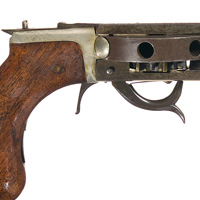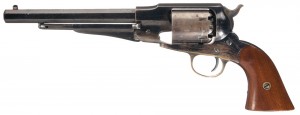

When it comes to fake antique guns, it's easy to wind up as the proud owner of a dud. Even a trained eye can be fooled by modern reproduction firearms that have been faked to look like the real thing.
The gun book business is the nuttiest enterprise I’ve ever been involved in. Take one of my recent projects, for example: The Gun Digest Book of Firearms Fakes and Reproductions by Rick Sapp.
I dreamed up this title after speaking to a number of prominent firearms auctioneers who told me that they’ve encountered a staggering amount of faked or fraudulent vintage firearms.
I thought that perhaps gun buyers would appreciate a nice little volume that showed them how to keep from getting burnt by buying a supposedly antique or rare firearm that’s really no such thing.

I could have used a book like this myself about 15 years ago when I was in a small antique store in Fort Wayne, Indiana, now long out of business. (I mean the antique store is out of business, not Fort Wayne. Come to think of it, Fort Wayne’s out of business, too.)
As I passed row after row of glass cases, I glanced down and there it was, unbelievably: a Cochran Turret Revolver.
The Cochran, as you might recall, had a cylinder that rotated horizontally, like a turntable, with the consequence that at least one of its chambers was always pointed back toward the shooter. Not a good quality to have in a percussion pistol, which have been known to chainfire.
I asked the elderly lady in charge to open the case so I could handle the Cochran. No doubt about it, it was obviously the real deal. Patinated finish, old-style nipples, saw-handle grip made of shrunken, dried-out walnut.
I furtively glanced at the price tag. Two hundred dollars for a Cochran! I drew my credit card with a noise like a whip cracking, and that was that. Well, not quite. I asked the lady to wrap up the Cochran in tissue paper and began mentally congratulating myself on being such a shrewd cookie.
I was almost out the door when the lady called after me, “Have fun with that! My husband made it in 1948 when he was a high school shop teacher. Bye-bye!”
I was too ashamed to ask for my money back, so I sold the pseudo-Cochran at a magnificent loss a short time later. Bye-bye indeed!
Had I read a decent book on firearms fakes, I would have kept that $200 and. . .and. . .well, I probably would have spent it on Stroh’s and onion rings. But that’s beside the point.
There’s an old saying that holds that you can’t judge a book by its cover. This is blasphemy in the book publishing business, where you damn well better be able to judge a book by its cover. So I had to think of some nifty photo for the cover that would really demonstrate what the book was about. Eureka! I’d show a faked gun.
Sounds simple enough, doesn’t it? Well, it wasn’t. No one I talked to wanted to fess up to owning a faked gun. In my wide-eyed naiveté, I had neglected to consider that owning a faked gun isn’t exactly something you’d want to brag about, let alone plaster all over the cover of a book.
Then a little bell rang in my head, and I picked up the phone and called Richard Clauss of Garrett, Indiana. Richard is a master at restoring relic firearms. Could he, I asked, reverse the process and reduce a new gun to a relic for the cover of my book?
At first, Richard balked at the idea. To suggest such a thing was like slapping him in the face with a dead carp. When I explained why I needed a faked “antique” gun, however, Richard reluctantly relented and agreed to help me. He clearly felt ill-used, however, and kept saying, “I don’t know, Daniel. Somehow this just doesn’t seem right.” These artists! Sheesh!
Next I had to find the right gun. It didn’t take long for me to get my hands on a brand-new Pietta 1858 Remington Army Model revolver for $200, give or take a few dimes.
Now, I really like Pietta guns and think they’re some of the best replicas on the market, right up there with Pedersoli and Uberti. When I took the big .44 out of its box, I began to share some of Richard’s misgivings.
The gun was almost too pretty to monkey with. But I had a job to do, by gum, so I packed it up and sent it off to Richard. Next I had to find an original 1858 Remington for Richard to use as a go-by. By great good luck, my associate Ken Ramage, editor of the annual Gun Digest book, has an original 1858 Remington in just the right condition, one that collectors would probably call “heavily patinated with virtually no traces of original finish.”
Ken’s gun was just as tight as it was when it left the factory in Ilion, New York, over 140 years ago. What a great old gun! I photographed it and sent the pictures to Richard with this instruction: “Make the Pietta look like this.”
Richard received the gun around noon on a Monday. At about 2 p.m. that same day he called me and asked, “You sure you want me to do this?” Hell yes, I said. Tuesday morning the phone rang again. It was Richard. “Are you really sure you want me to do this?” Yes, yes, yes. “Okay, then,” Richard said. “I’ll call you when it’s done.”
Two weeks later Richard called me. “It’s finished,” he said. I fired up the VW and sped down to Garrett. When I entered the shop, there was Richard holding a weathered, original 1858 Remington.“Where’d you get that?” I sputtered. “Did Ken Ramage send you that?” Richard looked at me as though I’d just hit my head on something. “You sent me that,” he said. “It’s your Pietta.”
No it wasn’t. Yes it was! Richard Clauss had come through for me again — and, as usual, he was apologetic. “It didn’t turn out the way I first thought it would,” he said. “I was going to put wrench marks on the barrel and punch some rust pits in it, but I just couldn’t do it. Couldn’t turn it into junk. I even plugged the barrel and chambers before I rusted it so you can still shoot it.”
I was delighted. I had asked Richard not to buff away the Italian markings, warnings and the Pietta name, since I didn’t want the gun to end up in somebody’s garage sale (probably mine) some day with a $600 price tag on it. But aside from the markings, the Pietta looked as though it had just spent the last 144 years in a barn in Appomattox, Virginia. How did Richard do it? Chemicals?
“No,” Richard said. “I tried to do it the way Nature would have done it. I built a little humidity cabinet and rusted the finish off it. Then I rubbed the gun with oil, degreased it, and browned it. Then I rusted that and started the whole process over again. I did that for a week and a half, and this is what I ended up with.”
And the grips? How did he age the grips?
“That was simple,” he said. “I just took them off and ground them into the gravel outside with my foot.”
Richard also explained that he had patinated the brass trigger guard with a commercially available solution made for that purpose. The result was a fake “antique” that would fool the casual, trusting buyer.
None of what Richard did was top-secret, but I wanted to be able to show the reader of the book how easily one could be led astray, and there was no way to do that except by demonstrating how realistic a faked gun could be.
I was delighted with the whole project, but Richard wasn’t.
“Daniel,” he said, “please don’t ever ask me to do this again, because I won’t. No good gunsmith should ever do such a thing.”
Amen, brother. I promised Richard that I’d pitch the gun into Simonton Lake before I ever sold it, and I meant it. The moral of the story? Caveat emptor, my friends. Let the buyer beware.

Next Step: Get your FREE Printable Target Pack
Enhance your shooting precision with our 62 MOA Targets, perfect for rifles and handguns. Crafted in collaboration with Storm Tactical for accuracy and versatility.
Subscribe to the Gun Digest email newsletter and get your downloadable target pack sent straight to your inbox. Stay updated with the latest firearms info in the industry.

![Best Concealed Carry Guns In 2025 [Field Tested] Wilson Combat EDC X9S 1](https://gundigest.com/wp-content/uploads/Wilson-Combat-EDC-X9S-1-324x160.jpg)


![Best 9mm Carbine: Affordable PCCs [Tested] Ruger Carbine Shooting](https://gundigest.com/wp-content/uploads/Ruger-Carbine-Shooting-100x70.jpg)
![Best AR-15: Top Options Available Today [Field Tested] Harrington and Richardson PSA XM177E2 feature](https://gundigest.com/wp-content/uploads/Harrington-and-Richardson-PSA-XM177E2-feature-100x70.jpg)

I’m about to inherit a black powder pistol and it may not be worth much but if real I’d love to know some of it’s history. My folks bought while stationed in Europe in the 60s. I have photos if anyone can help me, Thanks very much
The quality and deception some of these frauds will go to is amazing. In the just over forty years that I have been working with antique arms I am never at a loss for a new twist. As a museum conservator I see and handle a wide variety of rare and historic pieces. I find it necessary to study internal machine marks, thread manufacture even screw heads for authenticity. If necessary use high magnification of a metallurgical microscope as fake patina is difficult. It takes time and experience along with handling a great number of guns to “get the feel” of what is or is not correct. Read everything. Build a library suitable to your interests. In the words of my 85 year old father, “you can’t learn any younger.” After all, if something just doesn’t seem right, don’t buy it. If you are not allowed to closely inspect an expensive gun.. don’t buy it. Know your dealer and get return policies before you plunk down your hard earned cash.
I purchased 4 Model 70 Super Grade Winchesters from Rock Island Auction last spring and they were all faked. The description on their ad said “refurbished”, but they are clearly FAKES! I talked to the personell from Rock Island at Dallas Safari Club and I was very disappointed in their answers and offered no solution for me. Buyer Beware!